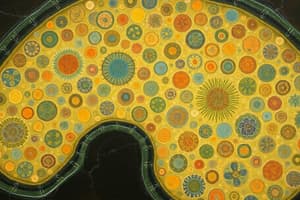Podcast
Questions and Answers
What is the basic unit of life?
What is the basic unit of life?
- Organelle
- Cell (correct)
- Organ
- Tissue
Which of the following is NOT a function of cells?
Which of the following is NOT a function of cells?
- Photosynthesis (in all cell types) (correct)
- Synthesis of molecules
- Cell metabolism
- Communication
- Reproductive and inheritance
What is the jelly-like substance that holds organelles?
What is the jelly-like substance that holds organelles?
- Cell membrane
- Nucleus
- Extracellular matrix
- Cytoplasm (correct)
The outermost component of a cell that acts as a selective barrier is the:
The outermost component of a cell that acts as a selective barrier is the:
The structure of the cell membrane is described as:
The structure of the cell membrane is described as:
Which part of the phospholipid in the cell membrane is hydrophilic?
Which part of the phospholipid in the cell membrane is hydrophilic?
The hydrophobic regions of phospholipids in the cell membrane are:
The hydrophobic regions of phospholipids in the cell membrane are:
Where are ribosomes located in the cell?
Where are ribosomes located in the cell?
Which organelle is responsible for modifying protein structure and packaging proteins in secretory vesicles?
Which organelle is responsible for modifying protein structure and packaging proteins in secretory vesicles?
The site of aerobic respiration and the major site of ATP synthesis is the:
The site of aerobic respiration and the major site of ATP synthesis is the:
Which cellular structure is responsible for propelling sperm cells?
Which cellular structure is responsible for propelling sperm cells?
What is the process of movement of molecules from areas of high to low concentration?
What is the process of movement of molecules from areas of high to low concentration?
Which of the following does NOT require ATP?
Which of the following does NOT require ATP?
In a hypotonic solution:
In a hypotonic solution:
The process of cell shrinkage in a hypertonic solution is called:
The process of cell shrinkage in a hypertonic solution is called:
In which type of solution does the cell remain intact with no net movement of water?
In which type of solution does the cell remain intact with no net movement of water?
What is the main function of the nucleus?
What is the main function of the nucleus?
Which organelle is the site of protein synthesis?
Which organelle is the site of protein synthesis?
What is the main function of the rough endoplasmic reticulum?
What is the main function of the rough endoplasmic reticulum?
The smooth endoplasmic reticulum is responsible for:
The smooth endoplasmic reticulum is responsible for:
Which organelle contains enzymes that digest material taken into the cell?
Which organelle contains enzymes that digest material taken into the cell?
What is the function of microtubules in the cell?
What is the function of microtubules in the cell?
Centrioles are involved in:
Centrioles are involved in:
What is the main function of cilia?
What is the main function of cilia?
Microvilli function to:
Microvilli function to:
The process of movement of fluid through a partition with holes is called:
The process of movement of fluid through a partition with holes is called:
What type of transport mechanism requires no ATP?
What type of transport mechanism requires no ATP?
Osmosis is defined as:
Osmosis is defined as:
In which solution would a cell burst (lysis)?
In which solution would a cell burst (lysis)?
The force required to prevent movement of water across a cell membrane is called:
The force required to prevent movement of water across a cell membrane is called:
Flashcards are hidden until you start studying
Study Notes
Basic Cell Biology Concepts
- Basic unit of life: Cell is recognized as the fundamental unit of life.
- Functions of Cells: Key functions include synthesis of molecules, communication, metabolism, and reproduction; photosynthesis is not a universal function.
- Cytoplasm: A jelly-like substance that houses organelles within the cell.
- Cell Membrane: The outermost layer acting as a selective barrier regulating entry and exit of substances.
Cell Membrane Structure
- Fluid Mosaic Model: Describes cell membrane structure as a flexible arrangement of various molecules, including phospholipids and proteins.
- Phospholipid Properties: The heads of phospholipids are hydrophilic (water-attracting), while the tails are hydrophobic (water-repelling).
Cellular Organelles and Their Functions
- Ribosomes: Sites of protein synthesis located in the cytoplasm.
- Golgi Apparatus: Modifies and packages proteins into vesicles for transport.
- Mitochondrion: The powerhouse of the cell, primarily responsible for aerobic respiration and ATP synthesis.
- Cilia and Flagella: Cilia move fluid over cell surfaces, while flagella propel sperm cells.
Transport Mechanisms
- Diffusion: Movement of molecules from high to low concentration, does not require energy (ATP).
- Facilitated Diffusion: A passive transport mechanism that also does not require ATP.
- Osmosis: Specific type of diffusion that involves the movement of water across a membrane.
- Hypertonic, Hypotonic, Isotonic Solutions:
- Hypotonic: Causes cells to swell as water moves into the cell.
- Hypertonic: Leads to cell shrinkage, known as crenation.
- Isotonic: No net movement of water; cells remain intact.
Organelles and Cellular Structures
- Nucleus: Contains genetic material (DNA) and is the site for RNA synthesis.
- Smooth Endoplasmic Reticulum: Involved in lipid synthesis and detoxification processes.
- Lysosomes: Contain enzymes that digest cellular materials.
- Microtubules: Provide structural support and play a role in cell division.
Additional Processes
- Active Transport: Requires ATP to move substances against their concentration gradient.
- Filtration: The movement of fluid through a porous partition, distinct from diffusion and osmosis.
Important Definitions
- Crenation: The process of cell shrinkage in hypertonic solutions.
- Lysis: The bursting of a cell due to excessive water influx, typically in hypotonic solutions.
Studying That Suits You
Use AI to generate personalized quizzes and flashcards to suit your learning preferences.




